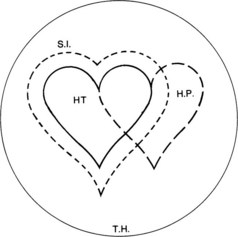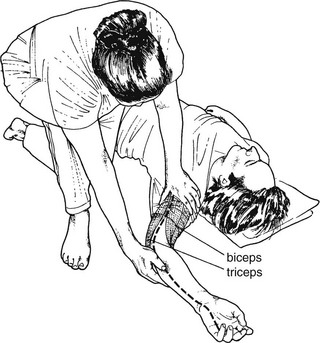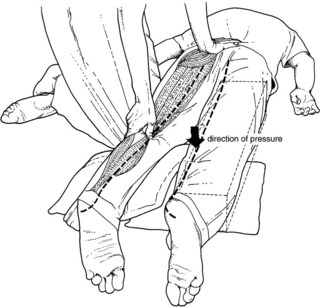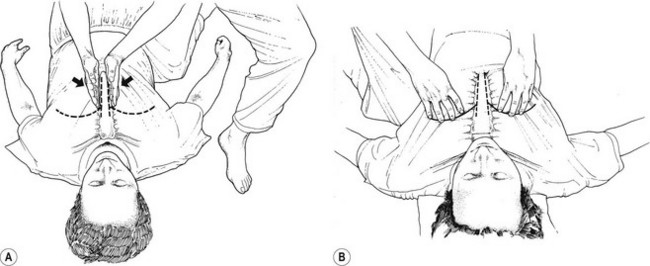CHAPTER 14 The Fire Phase
The Heart, Small Intestine, Heart Protector and Triple Heater
Hold in your heart all the sadness and pain of samsara, and at the same time the power and vision of the Great Eastern Sun: then the warrior can make a proper cup of tea.
Fire Associations: Transforming Power, Light, Warmth, Excitement, Movement, Responsiveness
Gazing into a fire is one of the best ways of attuning the conscious mind to the unconscious. The movement and flicker of fire provide a natural strobe effect which encourages the mind to produce alpha-waves, those associated with calmness and insight, and to flow in creative ways. For this reason the hearth has traditionally been the focus for social groups to express both their sense of community and their creativity by telling stories and singing songs. The warmth and comfort of the fire encourages relaxation and togetherness; the flickering, moving light induces a peaceful and creative frame of mind.
The Interrelationship of the Fire Meridians
The Small Intestine protects the Heart by assimilating only what is healthy, like the official taster who intercepts poisoned food. The Heart Protector protects in a different way, by mediating between the Heart and the surface via the circulation; in the texts, the Heart Protector is likened to an ambassador, but since it also takes on some of the Heart’s workload, we could think of it as a deputy for the Emperor on a more significant level, as a Prime Minister or Grand Vizier. The Triple Heater also has an ambassadorial function, conveying the Source Ki to all the organs of the Three Burning Spaces, thus mediating between the three districts of the realm. These relationships are depicted in Figure 14.1.
All of the above refers to the Chinese tradition still embodied in what we call traditional Chinese medicine (TCM). Masunaga, whose emphasis was on the meridians rather than the Phases, kept the two pairs of Fire meridians separate according to the Chinese Clock, and the relationship between the two pairs is not considered of great significance unless one of each pair comes up in a Hara diagnosis.
Spiritual capacity of Fire: Shen
As one of the Three Treasures (see p. 126) the human Shen is a ‘stepped-down’ version of the universal Shen, which is greater than the individual. The universal Shen is found in most religious traditions, under many different names. It can manifest as an experience of the union of our self with the essential oneness of all things, reached sometimes via our presence in the gaps between thoughts during meditation.
Movement of Fire energy: outwards
The movement of Fire has similarities to the movement of Wood, in that both, being Yang, have a tendency to go upwards when the element is out of balance. Fire, when it rages out of control, roars upwards, and pathogenic Fire creates symptoms in the upper part of the body, such as headaches, red or painful eyes in the case of Liver Fire, mouth ulcers in the case of Heart Fire or bleeding gums in the case of Stomach Fire. In all these cases, it also creates mental restlessness and agitation, often with insomnia, as the Fire rises up to disturb the Shen.
Fire emotion: joy
The Chinese character for the emotion of the Heart is perhaps mistranslated as ‘joy’, since:
Etymological study yields the meaning of ‘joy and pleasure derived from eating’.
(Fujido’s Etymological Dictionary, from Matsumoto & Birch 1998 p. 33)
Fire sound: laughing
The other side of the Fire imbalance is the second half of the quote – ‘empty shen is grief’. If Fire appears to be lacking, the receiver will often seem quiet and almost mournful, and laughs little unless encouraged by a display of warmth from another person.
Fire sense organ: the tongue
The Fire Phase is related to the tongue because of its ability to communicate, as the organ of speech, and not as the organ of taste, which is the connection between the mouth and the Earth Phase. Of course, speech is not the only means of communication between humans; a more intimate and open way of speaking one to another is with the eyes, and in fact the Shen is said to be visible in the eyes.*
Fire season: summer
The hottest season of the year is obviously that which belongs to Fire. It is the season of light and heat, of Yang at its peak of expansion and richness of manifestation. Energy has extended itself as far as it can go, out to the flowers and fruits of each plant; animals and birds have reared their broods of young. It is at this point, or rather, after the 10 days of Earth stillness at the end of this season (see p. 267), that the transition to Yin, the return to the cool, the dark, the still, must begin; there is nowhere else to go.
Fire climate: hot
As mentioned above, excessive external heat can place the body under strain. The Fire meridians suffer particularly, since the Blood must move faster around the circulatory system to cool itself at the Exterior, which puts pressure on the Heart and Heart Protector, and the Triple Heater must attempt to maintain a constant body temperature. A prolonged stay in a hot climate may produce an imbalance in these meridians.
The Heart in TCM
The home of the Shen
In ancient China, many conditions where the Shen, or consciousness, became scattered or uprooted would now be classified as shock, coma or critical states of illness with delirium; and many of these are still fatal, although technological methods of intensive care do often result in recovery. Other disorders where the Shen is scattered are nowadays classed as mental illnesses, such as schizophrenia, where the sufferer lives in another reality; his Shen is elsewhere; and recovery is as difficult today as it was then.
Heart Blood
Heart Blood can also stagnate as a result of repressed emotion (linked with the Liver in TCM, as above) which causes Stagnation of Ki and then Blood in the chest. This causes stuffiness, constriction or discomfort (Stagnation of Ki) or severe fixed pain (Stagnation of Blood) in the chest, with palpitations, as well as the other general symptoms of Ki or Blood Stagnation (see pp 121, 124).
Empty Heat
Empty Heat is caused by Deficiency of Heart Yin, an increasingly common condition which results from emotional stress accompanied by the depleting effects of our modern lifestyle on Kidney Yin. Heart Yin Deficiency or Empty Heat in the Heart may manifest with any of the general symptoms of Yin Deficiency (see p. 138), together with insomnia, restlessness, anxiety and palpitations.
The Heart Meridian and How to Treat it
The classical Heart meridian emerges from the deepest part of the armpit and travels down the arm between the biceps and the triceps (on the medial part of the anterior surface of the arm in the anatomical position), towards the little finger, where it ends at the lateral side of the little finger-nail (Fig. 14.2).
Masunaga extended the meridian into the chest, throat and legs. In the chest, the meridian ascends from the Hara diagnostic area, running under the edges of the sternum to the approximate level of the third intercostal space, where it branches, curving laterally over the chest towards the armpit where it joins the classical meridian. In the throat, the meridian runs along both sides of the floor of the lower jaw, connecting with the root of the tongue. On the leg, the Heart meridian lies just posterior to the traditional Kidney meridian, on the posterior surface of the thigh adductors, medial to the semitendinosus muscle, and in a straight line down the medial portion of the gastrocnemius in the lower leg, and on the medial side of the Achilles’ tendon, to curve under the foot into the pad of the heel.
The Hara diagnostic area is a small circle just below the meeting of the ribs and sternum (Fig. 14.2A).
The diagnostic area on the back is the area surrounding the 4th, 5th and 6th vertebrae, between the shoulder blades (Fig. 14.2B).
Treatment procedure
1. ![]() The Heart meridian in the arm can be palmed and thumbed in the supine or side positions, as long as the receiver’s arm is taken as far as comfortably possible above his head, which brings the meridian to the surface. It can also be worked in a similar stretch in the sitting position, with your fingertips reaching into the meridian as you grasp the receiver’s arm, which is bent behind his head. For ease of illustration, the supine position is shown in Figure 14.3.
The Heart meridian in the arm can be palmed and thumbed in the supine or side positions, as long as the receiver’s arm is taken as far as comfortably possible above his head, which brings the meridian to the surface. It can also be worked in a similar stretch in the sitting position, with your fingertips reaching into the meridian as you grasp the receiver’s arm, which is bent behind his head. For ease of illustration, the supine position is shown in Figure 14.3.
2. The legs are an excellent place to approach the Heart meridian when you want to bring the receiver’s Ki down. The easiest way to locate the meridian is to imagine the leg as a long box, with the meridian on the top surface of the medial corner. To locate it by muscle anatomy, it follows the medial border of the semitendinosus, and takes a straight line down till it curves under the foot into the center of the heel. The angle of pressure is straight down to the floor in prone position (Fig. 14.4), horizontal in the side position.
3. Following the border of the Achilles’ tendon, posterior to the Kidney meridian, the Heart descends the heel bone until it curves under the edge of the foot to end in the center of the pad of the heel. The angle of pressure changes on the heel bone; it ceases to apply from the back to the front of the leg, and becomes directed in towards the center of the area being worked on (normal perpendicular pressure).
4. The first part of the meridian in the chest lies just under the edges of the sternum, up from the Hara diagnostic area to roughly the level of the 3rd rib. You need to angle your pressure from the edges of the sternum underneath the bone to reach the meridian. Here the ulnar edges of the hands is shown, but fingertips between the intercostal spaces also work well (Fig. 14.5A).
5. The fingertips are the most suitable tool for working the rest of the meridian in the chest (Fig. 14.5B). It curves in a heart-shape outwards from the sternum, somewhat like the shape of a 1950s strapless dress. On large-breasted women, the meridian may lie on the outer breast tissue, so you need to avoid excessive pressure and use focus, intention and Hara to aid penetration.
6. Depending on the size of the area under the chin, the meridian here can be worked with the fingertips of one or both hands. If one hand is used, the mother hand should support the back of the neck (Fig. 14.6). If two hands are used, they can work alternately, with consecutive running pressures from all the fingertips.
Major points on the Heart meridian
The Small Intestine in TCM
The pairing of the Heart and Small Intestine is an odd one in physiological terms, even stranger than that of the Lungs and Large Intestine, and TCM does little to explain it. We know from modern embryological research in the West that the heart and the intestines develop in the embryo from the same layer of tissue (Matsumoto & Birch 1988, p. 171), but the originators of Chinese medicine reached their knowledge of the link between the two organs by some other route.
Stay updated, free articles. Join our Telegram channel

Full access? Get Clinical Tree














